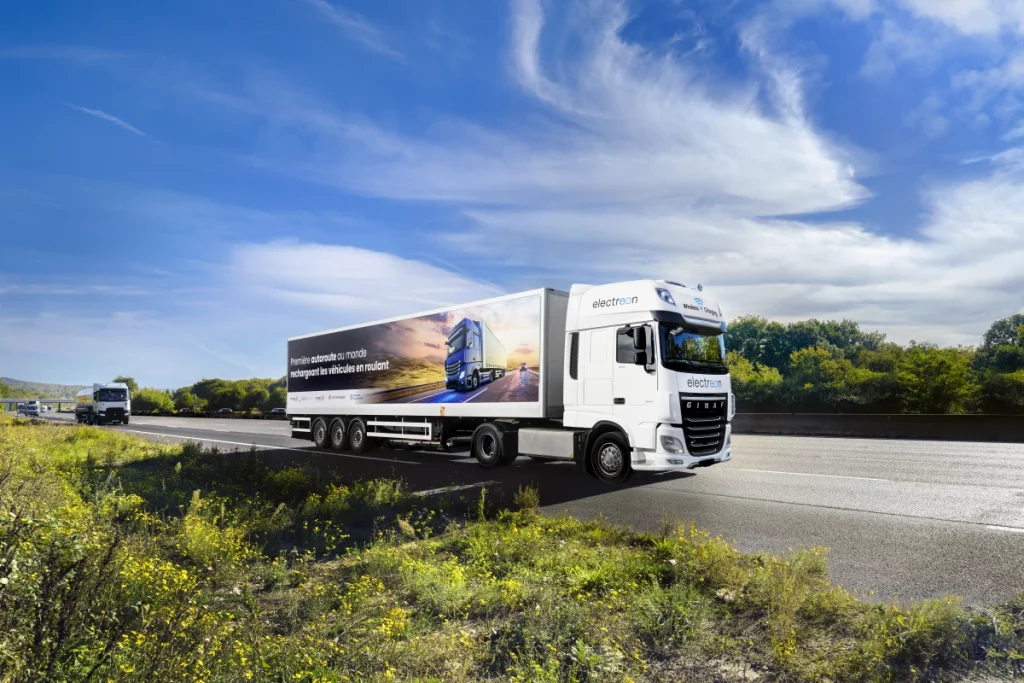• The world’s first in-motion wireless charging highway has launched on France’s A10, allowing trucks, buses, and cars to recharge while driving.
• Tests show Electreon’s system delivers over 200 kW on average—twice the power needed for a fully loaded heavy-duty truck—aligning with France’s Electric Road System roadmap.
• The project supports national goals to deploy 9,000 km of Electric Road Systems by 2035, offering a scalable model for decarbonizing freight and logistics.
A Live Testbed for Electric Mobility
On a four-lane stretch of the A10 near Paris, heavy-duty trucks are charging while cruising at full highway speed. This 1.5-kilometre pilot, led by VINCI Autoroutes in partnership with Electreon, VINCI Construction, Gustave Eiffel University, and Hutchinson, marks a technical and policy breakthrough for Europe’s energy transition.
Electreon’s dynamic wireless charging system transfers power directly through the road surface, eliminating the need for plugs or stops. The shared technology allows multiple vehicle classes—from passenger cars to freight trucks—to charge simultaneously. Backed by France’s innovation bank Bpifrance, the “Charge As You Drive” project represents the first real-world deployment capable of sustaining high-power transfer in continuous motion.
Proven at Highway Speeds
Independent laboratories at Gustave Eiffel University conducted mechanical, thermal, and electromagnetic tests under live traffic conditions. The results confirmed average power transfer above 200 kW and peaks beyond 300 kW—double the energy required by a heavy-duty truck to maintain speed and recharge simultaneously.
This outcome positions Electreon as the first company worldwide to demonstrate reliable, high-power dynamic charging for heavy vehicles at motorway speeds. For operators, it addresses one of the freight sector’s largest constraints: charging downtime. Vehicles on the A10 pilot are able to exit the highway with a higher charge than when they entered, offering an operational model that reduces battery size, shortens turnaround time, and lowers lifecycle costs.
Industry and Policy Convergence
“This marks a pivotal moment in the global development of wireless roads,” said Oren Ezer, CEO of Electreon. “Our system’s performance not only meets but exceeds French government targets. These results pave the way for the deployment of thousands of kilometres of wireless roads in France and beyond.”


The technology aligns directly with the French Ministry of Transport’s Electric Road System roadmap, which aims to electrify 9,000 km of national highways by 2035. Nicolas Notebaert, CEO of VINCI Concessions and President of VINCI Autoroutes, said early findings confirm the potential for large-scale integration: “Deploying this technology across France’s main road networks will accelerate heavy-vehicle electrification and reduce freight emissions, which account for more than 16% of the country’s total greenhouse gases.”


RELATED ARTICLE: France Budgets 500 Million Euros Annually for Green Industry Tax Credit
Global Race for Dynamic Charging
Electreon’s progress in France comes as governments and automakers seek scalable solutions to decarbonize freight and logistics. In the U.S., the company has built the country’s first public wireless charging road in Detroit and is collaborating with UCLA to power campus shuttles ahead of the 2028 Los Angeles Olympics. Utah’s ASPIRE Center is also testing Electreon’s system for heavy-duty Kenworth trucks and port logistics at Salt Lake City’s Inland Port.
Across Europe, Electreon is engaged in similar trials in Germany, Italy, and Sweden, establishing interoperability standards and cost benchmarks for the Electric Road System model. For investors, these pilot programs offer early insights into a market projected to reach tens of billions in infrastructure spending as public and private fleets shift away from fossil fuels.
C-Suite Takeaway
France’s wireless charging highway offers more than proof of concept—it reframes the economics of electric freight. By turning roads into distributed energy networks, Electreon and its partners are redefining infrastructure value chains and setting a precedent for how mobility, utilities, and construction sectors can converge under national decarbonization plans.
As governments push toward zero-emission transport corridors, the A10 experiment provides a tangible blueprint: highways that not only carry goods but power them in motion.
Follow ESG News on LinkedIn

